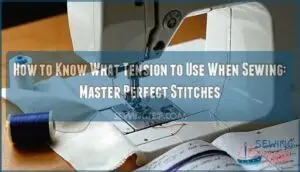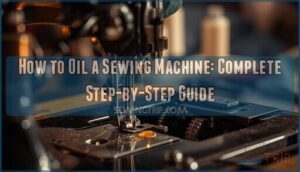This site is supported by our readers. We may earn a commission, at no cost to you, if you purchase through links.

Start with your machine’s default tension (usually 3-5), then sew a test seam. Check both sides of the fabric. Perfect tension creates balanced stitches where threads lock between fabric layers without puckering or loose loops.
If the top thread shows on the fabric’s underside, decrease tension. If bobbin thread appears on top, increase it. Don’t assume—even identical-looking fabrics can behave differently.
Your thread weight, fabric thickness, and needle size all play matchmaker in this delicate dance. The real magic happens when you understand why tension adjustments work, not just when.
Table Of Contents
Key Takeaways
- Test your tension on fabric scraps using the same thread, needle, and machine settings you’ll use for your project – this prevents costly mistakes on your actual work.
- Start with your machine’s default tension settings (usually 3-5) and make small adjustments – if you see top thread on the fabric’s underside, decrease tension; if bobbin thread shows on top, increase it.
- Your fabric weight, thread type, and needle size all affect tension requirements – lightweight fabrics need gentler settings while thick materials require firmer control.
- Perfect tension creates balanced stitches where threads lock between fabric layers without puckering or loose loops on either side of your seam.
Understanding Sewing Machine Tension
Mastering tension basics transforms your sewing from frustrating to flawless.
Your sewing machine tension controls how tightly the upper and lower threads pull during stitching, creating the foundation for professional results.
Think of thread tension control like a perfectly choreographed dance between your top thread and bobbin thread.
**Perfect tension is a conversation between threads, not a battle.
When balanced correctly, these threads lock together precisely in the fabric’s center, forming strong, even stitches.
Poor tension settings create chaos: puckered seams, thread nests underneath, or loops on top.
Most machines default to tension setting 4-5, your starting point for basic sewing techniques.
However, different fabric types demand specific machine settings adjustments.
Lightweight materials need gentler tension, while thick fabrics require firmer control.
Your thread tension guide lives on the machine’s dial, typically numbered 0-9.
Lower numbers mean looser tension; higher numbers tighten the grip.
Always test adjustments on fabric scraps first—this prevents project disasters and builds your confidence with tension adjustment techniques across various materials.
Factors Affecting Tension
Several key factors determine the right tension settings for your sewing project, and understanding them saves you from frustrating stitching problems.
Your fabric weight, thread type, and needle size work together like a recipe – get one ingredient wrong, and your whole seam suffers, because fabric weight is crucial.
Importance of Thread Tension
Thread tension acts as the silent conductor of your sewing orchestra, determining whether your stitches sing in harmony or clash discordantly.
Perfect thread tension is the heartbeat of every flawless seam.
Proper thread tension control guarantees thread balance between upper and bobbin threads, creating consistent stitch quality and ideal seam strength.
When tension’s off, you’ll see puckering, loose threads, or fabric stretch issues that compromise your project’s durability and appearance.
To achieve optimal results, understanding thread tension settings is vital for mastering various sewing techniques, ensuring a strong and visually appealing final product with proper thread tension.
Adjusting Top Thread Tension
Your sewing machine’s tension dial acts like a volume control for thread tightness. Start with your machine’s default setting—usually around 4 or 4.5—then test on fabric scraps using contrasting thread colors in the needle and bobbin.
When upper thread appears on the fabric’s underside, your top thread tension is too loose. Turn the dial to a higher number for increased tension. If bobbin thread shows on the fabric’s top surface, decrease the tension by turning to a lower number.
Make gradual adjustments—move one number at a time and test after each change. Proper thread balance creates even stitches on both fabric sides with no visible thread pulling through.
Check your threading path before adjusting tension settings. Missed thread guides or improper threading causes 80% of tension problems. Replace dull needles and clean lint from tension discs for accurate stitch quality. Understanding thread tension basics is essential for achieving perfect stitches. Remember: patience and small incremental changes lead to perfect thread control and professional-looking seams.
Troubleshooting Tension Issues
When your top thread tension adjustments don’t solve stitch quality problems, it’s time to dig deeper into systematic troubleshooting. Thread breakage and tension imbalance often stem from overlooked basics rather than dial settings alone.
Start by completely rethreading your machine with the presser foot up—this guarantees proper thread seating in tension discs. Lint buildup in these areas disrupts smooth thread flow, creating inconsistent results regardless of your settings.
Replace your needle if it’s bent or dull, as damaged needles cause fabric puckering and irregular stitching that mimics tension problems. Check that your bobbin rotates correctly and isn’t wound unevenly.
Tension troubleshooting requires patience, but methodical steps prevent frustration:
- Clean tension discs and bobbin area thoroughly – debris causes 70% of persistent tension issues.
Most sewing machine tension problems resolve through proper threading and maintenance rather than endless tension adjustment. This systematic approach guarantees thread breakage prevention and consistent results across all your projects. Understanding thread tension settings is vital for achieving perfect stitches and resolving common sewing issues.
How to Determine The Correct Tension
Perfect tension isn’t guesswork—it’s about knowing what to look for. Start with your machine’s default setting (usually 4 or 4.5) and test on fabric scraps before touching your project.
Thread balance becomes visible when you use contrasting colors for upper thread tension and bobbin thread, making it easy to spot which side shows through.
Here’s your tension testing roadmap:
- Set up your test: Use the same fabric types and thread weight as your actual project
- Sew a sample seam: Create a 4-inch test line with your planned stitch quality settings
- Examine both sides: Look for thread showing where it shouldn’t appear
- Adjust incrementally: Make small tension adjustment changes (0.25-0.5) between tests
Proper sewing thread tension shows threads meeting within the fabric layers, not on either surface. If you see bobbin thread on top, decrease upper thread tension. Lower thread tension showing underneath means you’ll need to increase the dial setting.
Remember, sewing speed affects stitch formation, so test at your intended pace.
Adjusting Bobbin Thread Tension
Once you’ve mastered top tension settings, bobbin thread tension becomes your next frontier. Start with the drop test—hold your threaded bobbin case and let it dangle. The case should drop about one inch when you gently jerk the thread, then stop.
If it drops too fast, your bobbin tension is loose; if it won’t budge, it’s too tight. Adjust the tiny screw on your bobbin case using quarter-turns. Remember "righty tighty, lefty loosey" but go easy—this isn’t a pickle jar.
Turn clockwise to tighten tension, counterclockwise to loosen it. Test between each adjustment. Your thread balance should feel just right when pulling—not racing freely or fighting you every step.
Perfect bobbin adjustment means smooth sewing tension without wrestling your machine. To achieve superior results, understanding bobbin thread is essential for mastering various sewing techniques.
Frequently Asked Questions (FAQs)
How do I choose a sewing machine tension guide?
Like finding the right recipe for success, choosing a sewing machine tension guide requires matching your fabric type, thread weight, and needle size.
Start with manufacturer recommendations, then test on scraps to dial in perfect settings.
What is a sewing machine tension?
Sewing machine tension controls how tightly your upper and lower threads pull during stitching.
When balanced correctly, threads interlock perfectly in your fabric’s center, creating strong, even seams without puckering or loose loops, which is crucial for even seams.
How do you control tension on a sewing machine?
Like clockwork precision from days of yore, you’ll master tension by turning the dial incrementally.
Start at your machine’s default setting, then adjust up or down based on fabric weight and test stitches.
How do I know if my sewing machine is tensioned?
Test your machine’s tension by sewing on fabric scraps using different colored threads for the needle and bobbin.
Properly tensioned stitches show threads interlocking evenly in the fabric’s center, creating balanced, flat seams without puckering or loose loops on either side, which results in flat seams.
Should you lower the tension on a sewing machine?
You should lower tension when stitches pucker, fabric bunches, or you’re using delicate materials. Start with small adjustments—reduce by 5 increments and test on scraps first.
Why is thread tension important in a sewing machine?
Eighty percent of tension problems stem from incorrect threading, making proper thread balance essential for strong seams.
You’ll need correct tension so your upper and lower threads interlock perfectly within fabric layers, preventing puckering, loops, and weak stitches that compromise your project’s integrity.
What tension should I use for different fabrics?
You’ll want tension at 2–3 for lightweight fabrics, 4–5 for thick materials like denim, and 2–3 for stretchy fabrics.
Always check with a scrap—machines love surprises, and fabric types change the game every time.
What tension to use for 100% cotton?
Funny coincidence—100% cotton likes a tension setting between 3 and
Aim for neat, flat stitches. If you spot puckering or loose threads, tweak the dial a notch.
Cotton’s forgiving, so don’t stress.
What tension setting works for metallic threads?
Use minimal tension (0-0) for metallic threads since they’re delicate and break easily. Start at 0, test on scraps, and adjust gradually. You’ll prevent snapping while achieving beautiful decorative stitches.
How does humidity affect thread tension?
Maintain 30-40% humidity for consistent results—your thread behaves differently in dry or humid conditions, causing tension to fluctuate and creating unpredictable stitching issues that’ll drive you crazy.
Conclusion
Like a rotary phone in a smartphone world, guessing tension settings is outdated.
You now know how to know what tension to use when sewing.
Test on scrap fabric, check both sides, and adjust top or bobbin tension as needed. Pay attention to thread, fabric, and needle details.
Balanced stitches mean your machine’s tension is set right. With these steps, you’ll avoid puckered seams and loose loops, ensuring every project starts—and finishes—strong.
- https://www.youtube.com/watch?v=b4JDAkByMlQ
- https://www.artisanstitch.co.uk/sewing-machine-tension/
- https://www.threadsmagazine.com/2008/11/02/understanding-thread-tension
- https://www.reddit.com/r/sewing/comments/10wv9xj/new_to_machine_sewing_how_does_tension_work/
- https://www.masterclass.com/articles/types-of-hand-sewing-stitches







